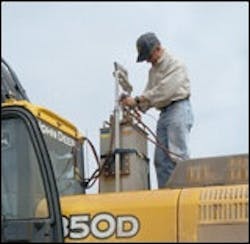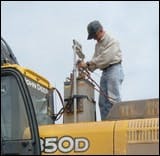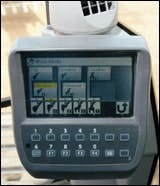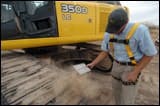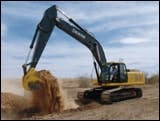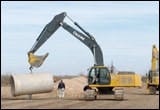John Deere's 350D Excavator Proves Its Potential
Refinement of D-Series serviceability includes fluid-sampling taps for engine oil and hydraulic fluid that are readily accessible and allow for drawing dynamic samples. Engine oil and fuel filters are remotely mounted in the pump compartment for accessibility, and the fuel filler's new position makes it easier to use. The 500-hour engine-oil change interval remains, but the hydraulic-oil change interval has been extended from 4,000 to 5,000 hours.
Comparative Trenching Data
For the trenching comparison, both machines were fitted with a 13 foot-1 inch (4-meter) digging arm and a 54-inch-wide bucket with a rated capacity of 2.3 cubic yards. Both machines have only one work mode, but three power modes, and were operated in their maximum-power (HP) mode, which provides a 100-rpm increase in engine speed when hydraulic-system pressure reaches a preset level.
Operator Marv Epperly opened two trenches with each machine, digging for 20 minutes per trench at a target depth of 12 feet. (Total linear distance for the four measured trenches exceeded 325 feet.) He worked as fast as the machines allowed, and did not take time to dress the bottom of the trench.
Cycles, cycle time and repositioning time were tracked electronically, and each cycle was recorded in three segments — dig, swing and dump and return to dig. Production and fuel-consumption data were processed immediately after each run, and the results for each machine's two runs could vary no more than 5 percent. (This criterion prompted us to open a third trench with the 350D.)
The magnitude of the differences in production and fuel efficiency between the two machines was unexpected, given that pressure and flow in the implement-hydraulic systems of both are essentially the same. The data indicate, however, that the 350D's nearly 24-percent advantage in production capacity was the result (in round numbers) of having been about 15 percent faster and 8 percent better at filling its bucket.
By way of explanation, we rely on the Deere crew's observations, as well as our own. Most obvious to us, was that the 350D is an extremely flat-footed digger. Not once did we see the machine get light in the back end, the result, we assume, of its increased weight. By contrast, the 330C did frequently lift off the rear of its tracks, requiring the operator to ease up on digging power. This could explain much of the 350D's bucket-fill advantage and faster cycle time.
The 350D's speed advantage was probably the result, mainly, of its ability to pull through tough digging more steadily and consistently than the 330C. Added to this is the speed the 350D gains though its boom and arm oil-regeneration systems and its 9-percent gain in swing torque (the result of gearing changes), which allows faster swing acceleration.
Truth be told, for us, the most notable finding in this exercise was the 350D's fuel efficiency. Basically, it delivered about 24 percent more production on the same amount of fuel used by the 330C. Obviously, Deere has done a good job with its new PowerTech Plus engines, and we assume that the lion's share of the 350D's fuel economy is the result of the new engine's efficiency. Add in the 350D's improved hydraulic efficiency, and the new machine, based on the Sacaton results, seems to be a fuel miser compared to its predecessor.
For the lifting comparison, the machines handled a large section of concrete pipe weighing 19,400 pounds and having an attached lifting hook. With the boom fully raised, the operator (Mike Boyle) increased the lifting radius (center of swing bearing to lifting hook) by arming out until the rear roller lifted from the track rail (over-end) or the rollers on one side lifted from the rails (over-side).
Based on sound-level checks done by test engineers Mauritzson and Tindall using SAE (Society of Automotive Engineers) guidelines, the 350D proved a much quieter machine, both inside the cab and for the bystander. According to Mark Wall, Deere's product marketing manager for excavators, the 350D's quieter operation results from a number of design changes. To begin, he says, the new PowerTech Plus engine is quieter than the 330C's engine by virtue of its block design and fuel system. Sound also is reduced significantly by using an on-demand, hydraulically driven cooling fan in the 350D, versus the 330C's conventional fan. In addition, says Wall, refinement of the 350D's hydraulic system results in quieter operation, as does its new dual-pass muffler and more effective isolation mounts under the cab.
Presented here are the differences in decibel readings recorded under various conditions. In all instances, the 350D was quieter by the decibel number shown. Keep in mind that very small reductions in decibel readings equate to significant sound reductions.
Although Deere's most pressing need for overhauling the top end of its hydraulic-excavator range was to bring these machines into Tier-3-emissions compliance, the company went well beyond just switching engines in the resulting new models — the D-Series. Construction Equipment recently had the chance to observe the results of Deere's effort by working with the company to compare the performance and features of a new D-Series representative, the 350D LC, with those of its predecessor, the 330C LC. After two days in the dirt with these machines, it was obvious that the 350D's added brawn and refinement pay off in convincingly superior performance.
The D-Series models, which replace C-Series models introduced in 2002, include the 240D LC, 270D LC, 350D LC, 450D LC, 650D LC and 850D LC. The new models range in operating weight from around 54,000 to 186,000 pounds, and in net horsepower from 177 to 532.
When developing the D-Series, Deere resized some of the new models to more closely match customer needs and the competitive environment. For instance, while the 270D and 450D are direct size replacements for their 270C and 450C predecessors, the new 240D is a bit larger than its 230C predecessor, and the 650D and 850D are significantly larger than their 600C and 800C forerunners.
The new 350D, our test machine, also is significantly larger and more powerful than its 330C predecessor. Its operating weight of around 77,300 pounds is some 4,500 pounds greater than the 330C's 72,800 pounds, and its 271 net horsepower is a notable jump from 330C's 246. So, by comparing the 350D with the 330C, were we comparing apples and oranges?
Deere says not. The company considers the 350D the direct replacement for the 330C, as well as for the larger 370C. The 350D was designed to split the gap between these two former models, says Mark Wall, product marketing manager for excavators, and provides the 330C user with a machine more in line with competitive-model specifications.
On the other side of the coin, the added capability of the 350D, says Wall, makes it a more-than-competent replacement for the 370C, which used the identical engine and implement hydraulic system as the 330C. The 370C, however, was fitted with a beefier undercarriage and more counterweight.
The site for our 350D/330C comparison was Deere's expansive Sacaton, Ariz., demonstration/training facility — winter headquarters for the company's professional operators and trainers who spend most of the year at Deere's companion facility in Coal Valley, Ill., near Moline. On hand from Deere for the evaluation were Wall; excavator instructors Andy Nicolas and Brian Ruppert; and test engineers Gary Mauritzson and Gary Tindall. Operators for the comparison were Marv Epperly and Mike Boyle.
The weather was unseasonably cool for early March in Arizona — downright cold, in fact, when the wind started gusting across the desert. The soil in which the machines worked during the trenching comparison was a tough-to-dig desert soil that weighed an estimated 2,100 to 2,200 pounds per cubic yard. Although the soil seemed almost powdery as it boiled out of the bucket at the top of the trench, gingerly touching the bucket teeth at the end of a trenching run and finding them probably hot enough to scorch your finger proved that the material was plenty tough to dig. Auxiliary fuel tanks on both machines allowed precise monitoring of consumption during the trenching comparisons.
For the over-end and over-side lifting comparisons, the machines handled a large section of concrete pipe rigged with a lifting hook. And for evaluating operator-ear and bystander sound levels, Mauritzson and Tindall employed good equipment and careful procedures, but since these numbers were not collected under strict laboratory conditions, we consider them unofficial. We'll tell you what the decibel differences were between the two machines, but not the absolute readings.
Our report includes detailed sidebars for the specific test events, but for a teaser version here, the 350D exhibited a double-digit advantage in trenching productivity and a similar advantage in fuel efficiency (cubic yards produced per gallon). The 350D's advantage in over-end lifting was also in double-digits, with a significant edge also in over-side picks. Sound checks showed substantial reductions, both at the operator's ear and for the bystander. But we caution the reader that all the numbers presented are specific to the Sacaton evaluation.
At the heart of the 350D's design is the new 9.0-liter John Deere PowerTech Plus diesel engine, which features a four-valve design, cooled EGR (exhaust gas recirculation), variable-geometry turbocharging, air-to-air charge-air cooling, a common-rail fuel system and a new electronic control module. The 330C used the conventionally turbocharged 8.1-liter John Deere 6018H diesel with air-to-air charge-air cooling.
Complementing the new engine is a new hydraulically driven cooling fan that replaces the 330C's conventional belt-driven fan. The new fan runs only on demand, says Deere, an efficiency that translates into less noise and less parasitic horsepower drain. Positioned between the engine and the coolers in the 350D's left rear fender, the fan, in normal operation, pulls in ambient air though perforated side sheets and across the coolers for engine coolant, hydraulic oil, charge-air, fuel and the air-conditioning system.
To keep coolers and side sheets clear in applications in which airborne debris can be a problem, an optional control system periodically reverses the fan's airflow (or the operator can initiate this feature on demand). If the optional reversing-fan feature is not chosen, an access panel on top of the fan shroud allows using an air wand to easily clean the coolers.
The two variable-displacement hydraulic pumps driven by the 350D's new engine have essentially the same flow as those used in the 330C, and pressures in the new machine's various hydraulic circuits remain essentially the same as those for its predecessor. Although the basics remain the same, Deere has done some refining in the 350D's implement-hydraulic system, and the overall result seems to be a notable increase in digging performance — along with a contribution to improved fuel economy.
Among the 350D's hydraulic refinements is the regenerative use of hydraulic fluid in the boom-down and arm-in circuits. Essentially, fluid exhausting from a particular circuit is channeled directly to another activated circuit, without first returning to the reservoir. This directly added fluid helps speed the activated function, relieves the hydraulic pump of having to move that volume of fluid and, consequently, helps to conserve fuel. Another significant refinement, says Deere's Wall, is the change in hydraulic-valve porting, which reduces backpressure in the valve by as much as 50 percent and, as a result, adds to overall hydraulic efficiency and reduces heat in the system.
In the major-structures department, the 350D's boom and digging arm have been "tweaked" in design, says Wall, but remain essentially the same as for the 330C. Larger D-Series models, he says, have significant changes in boom and arm design to accommodate much higher digging forces.
A structure that has been substantially overhauled, however, is the 350D's undercarriage. Much beefier in design than that of the 330C, the 350D's new undercarriage uses larger track frames, larger rollers, larger front idlers and heftier track links. Much of the 350D's weight gain resides in these larger undercarriage components.
Another source of the 350D's added weight is a larger carbody, which is that massive lower structure that houses the swing bearing and attaches to the track frames. We measured the overall height of the carbody at the center of each machine and found the 350D's to be more than an inch deeper, which translates into considerably more mass. Also, a much larger counterweight is a third source of the 350D's higher operating weight. The new counterweight has been made taller, however, and adds just 2 inches to the 350D's overall length, compared to the 330C.
Also taller — by 4 inches — is all of the 350D's sheet metal on the revolving frame. These redesigned panels give the 350D a more massive appearance, but add nothing to the overall height of the structure behind the cab, since the height of the engine hood has been reduced accordingly. But the new sheet metal is not only cosmetic; the added space it affords allows a larger fuel tank (166 versus 148 gallons) and a larger hydraulic tank (51.5 versus 42 gallons). As with the 330C, all the sheet metal is set back about an inch from the edge of the revolving frame, giving the panels a bit of added protection from jobsite hazards.
According to Wall, much of the refinement and many of the new features evident in D-series models resulted from insights provided by customer-advocate groups, which were invited to evaluate the D-series design as it progressed through the engineering process. No doubt, some of the features in the new D-Series cab were the result of this process.
For example, most operators, when traveling with an excavator, use just the tips of their boots on the bottom edge of the travel pedals, thus using their boot heels as a fulcrum point to precisely meter the travel function. But you can't operate this way if the space between the seat base and the pedals is constricted. So, to ensure enough foot room, Deere made the new cab 3 inches longer. And to improve the view, the front window and roof-hatch glass are larger, and a one-piece glass on the right side is, says Deere, 47 percent larger than that in the C-Series cab.
A notable refinement that's evident when you first sit in the new D-Series seat (air-suspension and heated cushions are optional) is the design of the pilot control levers, which are 2 inches shorter than those in the C-Series cab. That might not sound like a significant change, but the benefits are many: easier entering and exiting the cab; more room between the levers when you're in the seat; no hitting your legs with the levers in the maximum lateral position; and improved metering of hydraulic functions.
The jewel in the crown of the new D-Series cab, though, has to be the monitor. The new monitor, which can be programmed to report in 24 languages, has a normal display of such routine items as fuel level, fuel consumption, engine temperature and clock. But set the system to report operating conditions or diagnostic data, and the intelligence of the device begin to show. You can, for example, set the pressure and flow requirements of four hydraulic attachments, and when a particular attachment is installed, clicking on the appropriate icon instantly adjusts the hydraulics.
The monitor also tracks a host of maintenance items, allowing you, for example, to set service intervals. The system then tracks operating hours against the service-interval target, and alerts the operator when one hour remains. Pull up the diagnostic mode, and you have access to 32 functions that help troubleshoot various systems, all without the assistance of a laptop computer. Probably 98 percent of potential malfunctions, says Deere's Brian Ruppert, can be determined simply through the monitor.
Bigger, faster, stronger and quieter
During our visit to Sacaton, we were invited to briefly sit in on a dealer training session for the D-Series machines. Instructors Wall and Boyle continually emphasized the characteristics of D-Series models (compared to the C-Series counterparts) by saying, "they're bigger, faster, stronger and quieter."
Based on our experience with the 350D, which we assume is representative of the potential of other D-Series models, we couldn't say it any more succinctly.
| Test Set | |
|---|---|
| Type | Hydraulic excavator |
| New Model | 350D LC |
| Operating Weight | 77,300 lb. |
| Net Horsepower | 271 |
| Replaces Models | 330C LC and 370C LC |
| Available | March 2006 |
| Estimated List Price | $349,800 |
